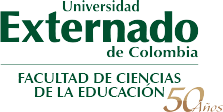24 de mayo de 2022
Contextualized materials on gender equity from a holistic view
Jhonatan Vásquez-Guarnizo
During the last decade, education has undergone a transformation process. This can be evidenced by reviewing the paradigmatic changes that have arisen as a consequence of the sociocultural development that our world is experiencing through its contexts and learning environments. Similarly, issues related to gender equity have been gaining strength in Latin American countries, such as Colombia, where it is transcending beyond the classroom. In this sense, thinking about having different public policies developed in other countries as a point of reference does not allow a real contextualization of our Colombian needs.
According to García (2012), comparative education does not exist as a science, but “as an applied methodology that, seen from a descriptive field, is usually referred to from a geographical perspective” (p. 20); for this reason, its approach depends on comparative education being an object or methodological field. That is to say, comparative education was born not as a negative response to aspects related to criticism, but rather as a broad vision of other realities to explore similarities and differences in educational systems and practices. Consequently, carrying out this comparative process enables teachers to settle down to the point of understanding what possible actions can be carried out within teachers’ educational bubble, which is directed to be focused on those teachers’ local needs they live every day.
In this sense, when going through this comparative process, from a holistic view, about how Colombia is placed regarding gender equity issues compared to a country like Sweden, there is still a long way to go. For example, there is a Ministry of Equality since 1954, and an Equality Law was issued from 1991 to 2009 when the Discrimination Law came into force. This law encompasses discrimination based on gender, race, religion, disability, and ideology, among others (Sweetsweden, 2011). Similarly, the Swedish Education Law establishes that gender equity must encompass and transcend all levels of education in the country; this is how Swedish education, from the earliest years, creates the same opportunities for boys as for girls (Sharingsweden, 2015). Thus, it is evident that Swedish education has stood out for meeting high standards in terms of equity, a reason that positively influences its development as a society.
In Colombia, although the Ministry of National Education (MEN in Spanish) has included gender equity issues, such as in the booklet: Inclusive education with quality (2008), the Guidelines – Inclusive Higher Education Policy (2013), the Inclusive Higher Education Index (INES) (2019), Law 1955 (2019), or the Gender Approach and Identities for the Policy Guidelines for Inclusive Higher Education (2022), these attempts to promote equity are insufficient for the local needs because there is no a cultural awareness of appropriation. Unfortunately, addressing gender equity issues, in some contexts, is still a taboo. Teachers in Colombia cannot let this transformation process remain on paper. As mentioned by Vásquez-Guarnizo et al. (2020), “It is essential to start raising awareness about gender […] in future language teachers” (p. 160), so that it is possible to “avoid seeing it [and addressing it in class] as a taboo” (Vásquez-Guarnizo et al., 2020, p. 160). Consequently, one might consider that “it is possible to have a world where diversity does not divide, but rather, in its own way, becomes an element that allows people to be united” (Vásquez-Guarnizo, 2022, p. 129) through a sociocultural transformation by means of designing contextualized materials, which visualize social realities that have silenced the voices of many in Colombia.
Beyond creating environments of respect in terms of gender equity processes, what is sought with the design of materials is to focus education towards the stimulation of human behavior by eradicating gender gaps. Understanding that each individual has different ways of acting, thinking, dressing, expressing themselves is what unites us as a society. However, one way to eradicate how beautiful it sounds in words is to take actions by visualizing realities that have been silenced for a long time. Taking actions would help to create awareness of a culture of respect and acceptance for the other. Sadly, gender gaps go beyond the curricular aspects of the teaching-learning process. Thus, designing contextualized materials becomes a possibility for the eradication of gender stereotypes.
Learning any language opens up millions of possibilities to understand, comprehend, accept, respect, learn, and resignify what individuals see, feel, and do as a society. Learning one or more languages opens a mental window that, helps humans better understand not only the context in which individuals interact, but also external contexts enabling people to connect with other cultures. For this reason, it is necessary to stimulate the planning, contextualization, and reconstruction processes from the different areas of knowledge: methodological, anthropological and even theological, to build a new horizon that revolves around respect for the other.
All in all, analyzing the implications that creating awareness through the design of materials would have to dispel gender gaps, it is possible to highlight that, teachers cannot continue replicating a hegemonic culture (De Sousa, 2018; Núñez-Pardo & Téllez-Téllez, 2021). In other words, thinking about adapting educational policies in relation to gender equity issues from other countries, such as Sweden, or Finland, which is a country run mostly by women (Moriyama & Doyle, 2022), would bring endless setbacks marked by our context. Based on Munévar (2017), contextualization deals with “real setting, design teaching resources, to accomplish meaningful and effective learning” (p. 13). In this way, thinking about designing contextualized materials (Kumaravadivelu, 2003, 2012, 2014; Núñez & Téllez, 2015; Núñez et al., 2006, 2012, 2017a, 2017b; Núñez-Pardo, 2018a; Ramos & Aguirre, 2014; Tomlinson, 2003; and Vásquez-Guarnizo, 2020) will empower teachers to critically make their own decisions regarding the teaching materials to be implemented in their classrooms.
Finally, it is pertinent to highlight the role of teachers within the educational process on their gender equity formation. The possibility of autonomy that every human being possesses cannot be set aside. Undoubtedly, the responsibility of guaranteeing the educational process alluding to gender equity as a fundamental axis within the construction of a free society, with opportunities for citizenship and one that works for everyone’s well-being lies in the hands of pre-service and in-service teachers. In this sense, comparative education not only works to guide the educational systems of a locality but also allows communities to open their horizons to new sociocultural environments and reconfigure their worldview.
Referencias
De Sousa, B. (2018). Construyendo las epistemologías del sur: Para un pensamiento alternativo de alternativas (Vol. 2). CLACSO.
García, R. (2012). La educación desde la perspectiva de género. Ensayos, Revista de la Facultad de Educación de Albacete, (27), 1-18.
Kumaravadivelu, B. (2003). Beyond methods: Macro strategies for language teaching. Yale University Press.
Kumaravadivelu, B. (2012). Individual identity, cultural globalization and teaching English as an international language: The case for an epistemic break. In L. Alsagoff, S. McKay, Gwangwei Hu y Renandya, W. (Eds.) (pp. 9 – 27). Principles and practice for teaching English as an International Language. Routledge.
Kumaravadivelu, B. (2014). The decolonial option in English Teaching. Can the subaltern act? TESOL Quarterly, 14(1), 66-85.
Ley 1955 (2019). Por el cual se expide el plan nacional de desarrollo 2018-2022 pacto por Colombia, pacto por la equidad. https://www.funcionpublica.gov.co/eva/gestornormativo/norma_pdf.php?i=93970
Ministerio de Educación Nacional, MEN. (2008). Educación inclusiva con calidad “Construyendo capacidad institucional para la atención a la diversidad” – Índice de inclusión, 2008. https://www.researchgate.net/publication/314151626_EDUCACION_INCLUSIVA_CON_CALIDAD_CONSTRUYENDO_CAPACIDAD_INSTITUCIONAL_PARA_LA_ATENCION_A_LA_DIVERSIDAD_Guia_y_Herramienta
Ministerio de Educación Nacional, MEN. (2013). Lineamientos – Política de Educación Superior Inclusiva. https://www.mineducacion.gov.co/1780/articles-357277_recurso_0.pdf
Ministerio de Educación Nacional, MEN. (2019). Índice de Educación Superior Inclusiva (INES). https://www.mineducacion.gov.co/1780/articles-357277_recurso_1.pdf
Ministerio de Educación Nacional, MEN. (2022). Enfoque e identidades de género para los lineamientos política de educación superior inclusiva. https://www.mineducacion.gov.co/1759/articles-357277_recurso_3.pdf
Moriyama, N., & Doyle, W. (2022). Así es como se ve una nación dirigida por mujeres. CNN en Español, plataforma virtual. https://cnnespanol.cnn.com/2022/03/08/opinion-nacion-dirigida-mujeres-finlandia-trax/
Munévar, M. (2017). Contextualized worksheets focused on tasks for two oral communication micro-skills. [Master’s thesis, Universidad Externado de Colombia]. Biblioteca digital, Universidad Externado de Colombia. https://bdigital.uexternado.edu.co/handle/001/512
Núñez, A., & Téllez, M. F. (2015). Reflection on teachers’ personal and professional growth through a materials development seminar. HOW, 22(2), 54-74. https://doi.org/10.19183/how.22.2.151
Núñez, A., Ramos, B., & Téllez, M. F. (2006). Reflexión en el contexto educativo: hacia la toma de decisiones en el aula. @puntes Cont@bles, 11, 111-115.
Núñez, A., Téllez, M. F., & Castellanos, J. (2017a). Materials development for teachers’ professional growth. In A. Núñez, M. F. Téllez & J. Castellanos (Eds.), Materials for the learning of English and teachers’ professional growth. (pp. 19-68). Departamento de Publicaciones Universidad Externado de Colombia.
Núñez, A., Téllez, M. F., & Castellanos, J. (2017b). Teacher–Developed Materials in a Master’s Programme in Education with Emphasis on English Didactics. In A. Núñez, M. F. Téllez, & J. Castellanos (Eds.), The role of teacher- developed materials in fostering English language skills (pp. 13-56). Departamento de Publicaciones Universidad Externado de Colombia.
Núñez, A., Téllez, M., & Castellanos, J. (2012). A framework for materials development: A path for in-service teachers to build up the instructional design of their research projects. In A. Núñez, M. Téllez & J. Castellanos (Eds.). Teacher research on English didactics issues. (pp. 17-38). Departamento de Publicaciones Universidad Externado de Colombia
Núñez-Pardo, A., & Téllez-Téllez, M. F. (Eds.) (2021). Defying culture hegemony through teacher generated EFL materials. Departamento de Publicaciones Universidad Externado de Colombia. https://bdigital.uexternado.edu.co/handle/001/4671
Núñez-Pardo, A. (2018a). The English textbook. Tensions from an Intercultural Perspective. GIST – Education and Learning Research Journal, 17, 230-259. https://doi.org/10.26817/16925777.402
Ramos, B., & Aguirre, J. (2014). Materials development in the Colombian context: Some considerations about its benefits and challenges. HOW Journal, 21(2), 134-150. https://doi.org/10.19183/how.21.2.8
Sharingsweeden (2015). La perspectiva sueca de la equidad. Datos sobre Suecia / Equidad de Género. https://sharingsweden.se/app/uploads/2015/06/Igualdad-de-genero-Low-Resolution.pdf
Sweetsweden (2011). La igualdad de género en Suecia. https://www.sweetsweden.com/otros/la-igualdad-de-genero-en-suecia/#:~:text=En%20sueco%20se%20conoce%20a,o%20entorpecimiento%20al%20desarrollo%20personal.
Tomlinson, B. (2003). Materials development in language teaching. Continuum.
Vásquez-Guarnizo, J. (2020). It is time to become producers of contextualized knowledge. Revista Virtual Cuestiones Educativas, agosto. Universidad Externado de Colombia. https://cuestioneseducativas.uexternado.edu.co/it-is-time-to-become-producers-of-contextualized-knowledge/
Vásquez-Guarnizo, J. (2022). Equidad de género en Colombia: Una mirada holística de este problema sociocultural. ENLETAWA Journal, 14(2), 125-131. https://doi.org/10.19053/2011835X.14110
Vásquez-Guarnizo, J., Chía-Ríos, M., & Tobar-Gómez, M. F. (2020). EFL Students’ perceptions on Gender Stereotypes through their Narratives. GIST –Education and Learning Research Journal, 21, 141-166. https://doi.org/10.26817/16925777.836


